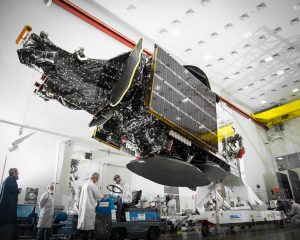On July 22nd, the heaviest commercial satellite ever launched was sent into space. Weighing in at more than 7,000 kilograms. Telstar 19 Vantage was built by spacecraft manufacturer SSL for Canadian operator Telesat, along with Telstar 18 Vantage, which was launched on September 10th. The two will orbit 36,000 kilometers above Earth and deliver high speed communications services, including broadband Internet, to Asia and the Americas for the next 15 years.
 Both Telstar 18 and 19 Vantage were built and customized using 3D printing. The technology has been used to create many satellites over the past few years, from tiny CubeSats to much larger communications satellites. The Telstar satellites are definitely of the larger variety, but their beams are more focused than other geosynchronous satellites of their ilk. Satellites like the Telstar pair are capable of covering almost half the world’s population from certain angles, but these new satellites additionally use spot beams, which are focused rays of electromagnetic energy that can transmit more data to smaller areas than typical wide beams can manage.
Both Telstar 18 and 19 Vantage were built and customized using 3D printing. The technology has been used to create many satellites over the past few years, from tiny CubeSats to much larger communications satellites. The Telstar satellites are definitely of the larger variety, but their beams are more focused than other geosynchronous satellites of their ilk. Satellites like the Telstar pair are capable of covering almost half the world’s population from certain angles, but these new satellites additionally use spot beams, which are focused rays of electromagnetic energy that can transmit more data to smaller areas than typical wide beams can manage.
“An analogy is the human eye and the insect compound eye,” said Rob Schwarz, SSL’s acting Chief Technology Officer. “The human eye is one wide view, while the compound eye is like spot beams.”
The spot beams produced by 18V and 19V will focus in slightly different directions, allowing the same spectrum bands to be used multiple times without interference. The satellites will layer both wide beams and spot beams, like a compound contact lens over a human eye.
“There will be a backdrop of broad-area beams, and in high-density areas, we’re adding spot beams to aid coverage,” said Schwarz.
The 18V and 19V satellites use the Ku (12 to 18 gigahertz) and Ka (26 to 40 GHz) bands for both their spot beams and wide beams. These bands have become more popular in recent years because they deliver higher data rates, although they do tend to have higher signal loss in the atmosphere, especially in rainy climates. The 18V and 19V, along with a third satellite called Merah Putih, built by SSL for Telkom Indonesia, are based on the SSL 1300 framework and required specialized antenna arrays, which had to support spot beams in the case of the Telesat satellites.
The Telstar satellites have 3D printed components in the antenna struts, which support antennas, tracking equipment, and satellite control equipment. Using 3D printing for the satellites has a number of advantages: it speeds up production, as well as allowing the production of strong joints with more complex shapes than those allowed by traditional manufacturing. It also cuts down on costs.
Each new communication satellite must spend about 10 days under its own propulsion to reach its final geosynchronous orbit. Once they reach orbit, they deploy their solar arrays and open their antennas. SSL contacts each satellite and runs checks on each system to make sure the equipment is in optimal condition. SSL handles operations for 30 to 40 days before passing the satellites along to their operators. If all goes smoothly, the satellites will operate for 15 years until just before they run out of propellant, at which point they will be boosted to a higher “graveyard” orbit.
“The graveyard orbit is for the good satellites who have completed their operations,” said Schwarz.
Discuss this and other 3D printing topics at 3DPrintBoard.com, or share your thoughts below.
[Source: IEEE Spectrum/Images: SSL]
Subscribe to Our Email Newsletter
Stay up-to-date on all the latest news from the 3D printing industry and receive information and offers from third party vendors.
Print Services
Upload your 3D Models and get them printed quickly and efficiently.
You May Also Like
Havaianas Collaborates with Zellerfeld to Launch 3D Printed Flip-Flops
The shoe of the summer is undoubtedly the flip-flop. Easy on, easy off, your feet won’t get sweaty because there’s not much material, and they’re available in a veritable rainbow...
UCLA Researchers Develop 3D Printed Pen that May Help Detect Parkinson’s Disease
Diagnosing Parkinson’s disease is difficult. Often, early symptoms of the progressive neurological condition may be overlooked, or mistaken for signs of aging. Early diagnosis can help save lives and improve...
Printing Money Episode 30: Q1 2025 Public 3D Printing Earnings Review with Troy Jensen, Cantor Fitzgerald
Printing Money is back with Episode 30, and it’s that quarterly time, so we are happy and thankful to welcome back Troy Jensen (Managing Director, Cantor Fitzgerald) to review the...
Heating Up: 3D Systems’ Scott Green Discusses 3D Printing’s Potential in the Data Center Industry
The relentless rise of NVIDIA, the steadily increasing pledges of major private and public investments in national infrastructure projects around the world, and the general cultural obsession with AI have...


































